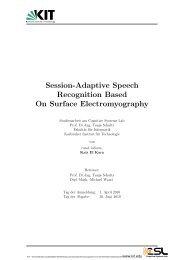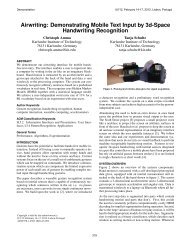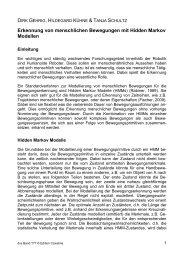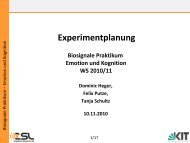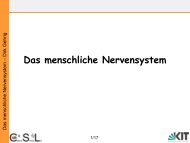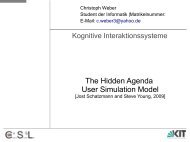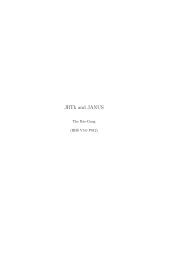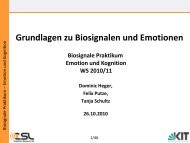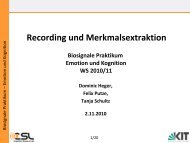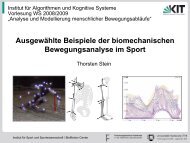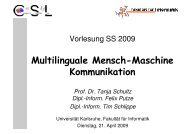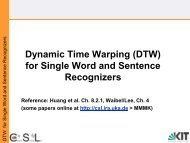How to solve homophone problems in Automatic Speech Recognition
How to solve homophone problems in Automatic Speech Recognition
How to solve homophone problems in Automatic Speech Recognition
You also want an ePaper? Increase the reach of your titles
YUMPU automatically turns print PDFs into web optimized ePapers that Google loves.
<strong>How</strong> <strong>to</strong> <strong>solve</strong> <strong>homophone</strong> <strong>problems</strong> <strong>in</strong> ASR ? - 1<br />
<strong>How</strong> <strong>to</strong> <strong>solve</strong> <strong>homophone</strong> <strong>problems</strong> <strong>in</strong> Au<strong>to</strong>matic<br />
<strong>Speech</strong> <strong>Recognition</strong>?<br />
„Based on material from Béchet (1999) et al. and Nemo<strong>to</strong> et al. (2008)“<br />
Ivaylo Yanev<br />
Advisor: Tim Schlippe<br />
04-02-2011
<strong>How</strong> <strong>to</strong> <strong>solve</strong> <strong>homophone</strong> <strong>problems</strong> <strong>in</strong> ASR ? - 2<br />
Outl<strong>in</strong>e<br />
ffw 1. Introduction<br />
2. Solution on language model (LM) level<br />
2.1 Motivation<br />
2.2 Phase-based language model (LM)<br />
2.3 Cache-based language model (LM)<br />
2.4 Model Comb<strong>in</strong>ation Experiments<br />
3. Acoustic and prosodic <strong>in</strong>formation<br />
3.1 Motivation<br />
3.2 Perceptual Errors (Human Errors)<br />
3.3 Au<strong>to</strong>matic Transcription Errors (Errors of ASR)<br />
3.4 Classification with acoustic and prosodic attributes<br />
4. Conclusion
<strong>How</strong> <strong>to</strong> <strong>solve</strong> <strong>homophone</strong> <strong>problems</strong> <strong>in</strong> ASR ? - 3<br />
1. Introduction<br />
• Challenges for ASR: Homophones<br />
• Homophone: word hav<strong>in</strong>g different orthography with the same phonetic<br />
transcription<br />
• Here: Investigation for French<br />
• Facts about <strong>homophone</strong>s <strong>in</strong> French:<br />
• S<strong>in</strong>gular/Plural <strong>in</strong>flection<br />
• Homophone forms <strong>in</strong> French: e.g. et („and“) and est („is“),<br />
especially different verb forms, e.g. tuer, tué, tués... “<strong>to</strong> kill”, allez (you go),<br />
aller (<strong>to</strong> go), allé (gone (m)), allés (gone (f))<br />
• Each word <strong>in</strong> average belongs <strong>to</strong> <strong>homophone</strong> class of 2.2 elements (paper 1,<br />
Bechet et al.)<br />
• Humans dist<strong>in</strong>guish <strong>homophone</strong>s with context knowledge<br />
• But the context knowledge is very limited <strong>in</strong> ASR (Au<strong>to</strong>matic <strong>Speech</strong> <strong>Recognition</strong>)<br />
Homophones: One of specific <strong>problems</strong> for ASR <strong>in</strong> French
<strong>How</strong> <strong>to</strong> <strong>solve</strong> <strong>homophone</strong> <strong>problems</strong> <strong>in</strong> ASR ? - 4<br />
1. Introduction<br />
• I present here two papers that describe how <strong>to</strong> deal with <strong>homophone</strong>s:<br />
• Paper 1: Large span statistical language models: Application <strong>to</strong> <strong>homophone</strong><br />
disambiguation for large vocabulary speech recognition <strong>in</strong> French<br />
(Frédéric Béchet, Alexis Nasr, Thierry Spriet, Rena<strong>to</strong> de Mori, Euro<strong>Speech</strong> 1999)<br />
• Paper 2: <strong>Speech</strong> errors on frequently observed <strong>homophone</strong>s <strong>in</strong> French:<br />
Perceptual evaluation vs au<strong>to</strong>matic classification<br />
(Rena Nemo<strong>to</strong>, Ioana Vasilescu, Mart<strong>in</strong>e Adda-Decker, LREC 2008)
<strong>How</strong> <strong>to</strong> <strong>solve</strong> <strong>homophone</strong> <strong>problems</strong> <strong>in</strong> ASR ? - 5<br />
2.1 Large span statistical language models: Motivation<br />
• Confusion pairs for French <strong>homophone</strong>s particularly high for some s<strong>in</strong>gular/plural<br />
<strong>in</strong>flections (e.g. diffusé/s )<br />
Focus of paper 1 (Béchet et al., 1999)<br />
• Analyses of local LMs such as 3-gram or 3-class LMs with POS (Part-of-<strong>Speech</strong>),<br />
large-span LMs and comb<strong>in</strong>ation of these LMs<br />
• In paper 1 - two k<strong>in</strong>ds of models:<br />
• Local LMs:<br />
• 3-gram LM (words)<br />
• 3-class LM with 105 POS<br />
• Large-span LMs:<br />
• Phrase-based LM: Phrase-patterns from clusters of POS sequences<br />
• (Homophone) Cache-based LM: Vec<strong>to</strong>rs with POS his<strong>to</strong>ries of s<strong>in</strong>gular<br />
and plural <strong>homophone</strong>s <strong>to</strong> determ<strong>in</strong>e adequate form
<strong>How</strong> <strong>to</strong> <strong>solve</strong> <strong>homophone</strong> <strong>problems</strong> <strong>in</strong> ASR ? - 6<br />
2.2 Experiments with 3-gram LM, 3-class LM and<br />
phrase-based LM<br />
• Likelihood of sentence hypothesis = L<strong>in</strong>ear comb<strong>in</strong>ation of probabilities<br />
of 3-gram LM on words, 3-class LM on POS and 3-class LM on phrases<br />
• 3-gram LM: on words<br />
• 3-class LM on POS: LM with POS tags (# POS tags=105)<br />
• 3-class LM on phrases:<br />
1. tag corpus with statistic tagger<br />
2. parse tagged corpus with f<strong>in</strong>ite state parser <strong>to</strong> recognize syntactic phrases<br />
(e.g. nom<strong>in</strong>al, verbal, prepositional syntagms)<br />
3. label each phrase accord<strong>in</strong>g <strong>to</strong> its syntactic structure<br />
phrase patterns (larger context)
<strong>How</strong> <strong>to</strong> <strong>solve</strong> <strong>homophone</strong> <strong>problems</strong> <strong>in</strong> ASR ? - 7<br />
2.2 Phrase-based LM<br />
• Table 1: Result of correct<br />
analysis of a sentence:<br />
• Words <strong>in</strong> bold:<br />
S<strong>in</strong>gular/Plural <strong>homophone</strong>s<br />
• Correctly disambiguated<br />
<strong>homophone</strong>s: marked with *<br />
3-class LM on POS realises<br />
agreement between verb<br />
„constituent“ and noun „justice“<br />
<strong>in</strong>stead of its subject „valeurs“ (false<br />
would be: „constituet“ )<br />
POS on words<br />
POS on phrases<br />
3-gram LM on POS 3-gram LM on phrases<br />
3-gram LM on words<br />
Table 1 - Pars<strong>in</strong>g example
<strong>How</strong> <strong>to</strong> <strong>solve</strong> <strong>homophone</strong> <strong>problems</strong> <strong>in</strong> ASR ? - 8<br />
Shortcom<strong>in</strong>gs of 3-gram LM, 3-class LM and<br />
phrase-based LM<br />
• Some cases: difficult <strong>to</strong> process with phrase-based and with (more<br />
generally) syntactic-based LMs:<br />
1. Overlapp<strong>in</strong>g prepositional syntagms (=phrases or sentences) or<br />
relative clause, co-ord<strong>in</strong>ate clauses, etc.<br />
Syntactic constra<strong>in</strong>ts not captured by simple grammars<br />
2. Syntactically undecidable or really ambiguous cases<br />
• Solution <strong>to</strong> 1: Full syntactic pars<strong>in</strong>g (but such a pars<strong>in</strong>g very difficult <strong>to</strong><br />
<strong>in</strong>tegrate <strong>in</strong> a speech decod<strong>in</strong>g process due <strong>to</strong> coverage and complexity)<br />
• Solution <strong>to</strong> 2: Lexical or Semantic <strong>in</strong>formation: needed <strong>to</strong> remove<br />
ambiguities (by number agreement):<br />
• Example: „Le président Boris Elts<strong>in</strong>e dans un message de voeux<br />
diffusé à la télévision russe“<br />
• The number agreement beween 'diffusé' and 'message' (s<strong>in</strong>gular)<br />
rather than 'voeux' (plural) can't be predicted by a syntactic model
<strong>How</strong> <strong>to</strong> <strong>solve</strong> <strong>homophone</strong> <strong>problems</strong> <strong>in</strong> ASR ? - 9<br />
Shortcom<strong>in</strong>gs of 3-gram LM, 3-class LM and<br />
Phrase-based LM<br />
• Substitutions, <strong>in</strong>sertions and deletions errors occurr<strong>in</strong>g dur<strong>in</strong>g decod<strong>in</strong>g<br />
process make full syntactic pars<strong>in</strong>g nearly impossible<br />
• Example: True: Valeurs (pl.) de justice ne constituent (pl.)<br />
prices<br />
w<strong>in</strong>d<br />
False: Vent de justice ne constitue (s<strong>in</strong>g.) (here was valeurs<br />
false confused with vent<br />
• But strong syntactic constra<strong>in</strong>ts <strong>in</strong>crease WER dramatically!<br />
Decision LM: Robust <strong>to</strong> speech recognition errors, which can take a<br />
decision on the number of a <strong>homophone</strong> word without strong<br />
syntactic constra<strong>in</strong>ts<br />
Cache-based LM presented <strong>in</strong> follow<strong>in</strong>g slides<br />
Substitution<br />
error of valeurs
<strong>How</strong> <strong>to</strong> <strong>solve</strong> <strong>homophone</strong> <strong>problems</strong> <strong>in</strong> ASR ? - 10<br />
2.3 Cache-based LM<br />
• Cache-based LM s<strong>to</strong>res each s<strong>in</strong>gular/plural <strong>homophone</strong> and its left<br />
contexts (= word his<strong>to</strong>ries made of last ten words s<strong>to</strong>red <strong>in</strong> cache<br />
memory) as seen <strong>in</strong> tra<strong>in</strong><strong>in</strong>g corpus<br />
• Each cache content vec<strong>to</strong>r C(w), whose components are syntactic<br />
POSs assigned <strong>to</strong> words by tagger (size of vec<strong>to</strong>rs = 105 (= #POS))<br />
• Tra<strong>in</strong><strong>in</strong>g of LM: Us<strong>in</strong>g tra<strong>in</strong><strong>in</strong>g corpus for updat<strong>in</strong>g two cache memory<br />
vec<strong>to</strong>rs for each <strong>homophone</strong> w:<br />
• CP(w): contexts of plural flexion of w<br />
• CS(w): contexts of s<strong>in</strong>gular flexion of w<br />
• Decod<strong>in</strong>g: Two distances computed, when two s<strong>in</strong>gular/plural<br />
<strong>homophone</strong>s of same w <strong>in</strong> competition:<br />
1-st distance between CP(w) and the current cache and<br />
2-nd distance between CS(w) and the cache<br />
The used distance is a symmetric Kullback-Leibler divergense<br />
measure
<strong>How</strong> <strong>to</strong> <strong>solve</strong> <strong>homophone</strong> <strong>problems</strong> <strong>in</strong> ASR ? - 11<br />
2.3 Cache-based LM<br />
• 'diffusé': s<strong>in</strong>gular/plural <strong>homophone</strong><br />
(=w) can either be s<strong>in</strong>gular or plural,<br />
depend<strong>in</strong>g on agreement with<br />
'message' or 'voeux‚<br />
• Cache memory vec<strong>to</strong>r A(w) based on<br />
9 words, preced<strong>in</strong>g word 'diffusé'<br />
• A(w) is than compared with CP(w)<br />
and CS(w), associated <strong>to</strong> 'diffusé'<br />
• |dist(A,CS)-dist(A,CP)| > th<br />
• When satisfied than select flexion<br />
whose vec<strong>to</strong>r closest <strong>to</strong> the current<br />
one (=A(w))<br />
• CS(w) has here m<strong>in</strong>imum distance<br />
and represents the s<strong>in</strong>gular flexion<br />
of 'diffusé'<br />
1 Le DETMS<br />
2 président NMS<br />
3 Boris XPRE<br />
4 Elts<strong>in</strong>e XFAM<br />
5 dans PREP<br />
6 un DETMS<br />
7 message NMS<br />
8 de PREP<br />
9 voeux NMP<br />
10 diffusé<br />
or<br />
diffusés<br />
VPPMS<br />
or<br />
VPPMP
<strong>How</strong> <strong>to</strong> <strong>solve</strong> <strong>homophone</strong> <strong>problems</strong> <strong>in</strong> ASR ? - 12<br />
2.4 Results of Model Comb<strong>in</strong>ation Experiments<br />
Disadvantages Advantages<br />
• M3 and M4 are less precise<br />
than n-grams<br />
• M4 does not capture all syntactic<br />
constra<strong>in</strong>ts (cache small, applied<br />
only <strong>to</strong> <strong>homophone</strong>s)<br />
LM M1<br />
(3-gram<br />
LM on<br />
words)<br />
M2<br />
(3-class<br />
LM with<br />
105 POS)<br />
M3<br />
(phrasebased)<br />
M4<br />
(cachebased)<br />
• M3 and M4 cover some useful<br />
cases not covered by the other<br />
models<br />
M1+M2 M1+M3 M2+M3 M1+M2<br />
+M3<br />
M1+M2+<br />
M3+M4<br />
WA 90.95 95.36 89.02 84.59 96.89 96.14 96.22 96.98 97.36
<strong>How</strong> <strong>to</strong> <strong>solve</strong> <strong>homophone</strong> <strong>problems</strong> <strong>in</strong> ASR ? - 13<br />
3.1 Acoustic and prosodic <strong>in</strong>formation - Motivation (I)<br />
• Perceptual vs au<strong>to</strong>matic transcription errors<br />
• Focus of paper 2 (Nemo<strong>to</strong> et al., 2008) <strong>in</strong> terms of et /est <strong>homophone</strong>s<br />
• „et“ (conjunction) and „est“ (verb) different part of speech<br />
Occupy dist<strong>in</strong>ct positions <strong>in</strong> sentences<br />
Different prosodic realization of words (e.g. the duration of the<br />
words and the fundamental frequency)<br />
• Make acoustic analysis of appropriate acoustic and prosodic<br />
attributes<br />
• Prosody: the rythm, stress and <strong>in</strong><strong>to</strong>nation of speech (www.wikipedia.org)<br />
• Reflect various features of speaker (emotional state) or<br />
utterance (statement, question, command)
<strong>How</strong> <strong>to</strong> <strong>solve</strong> <strong>homophone</strong> <strong>problems</strong> <strong>in</strong> ASR ? - 14<br />
3.1 Acoustic and prosodic <strong>in</strong>formation - Motivation (II)<br />
• Use of the French Technolangue-ESTER corpus: broadcast<br />
news shows from different francophone (French and<br />
Moroccan) radio stations<br />
• Extraction of au<strong>to</strong>matic transcription errors by the LIMSI<br />
speech recognition system
<strong>How</strong> <strong>to</strong> <strong>solve</strong> <strong>homophone</strong> <strong>problems</strong> <strong>in</strong> ASR ? - 15<br />
3.1 Acoustic and prosodic <strong>in</strong>formation - Motivation (III)<br />
• Fundamental frequency (f 0 (or F 0)): the lowest frequency of a periodic waveform<br />
(www.wikipedia.org)<br />
• Formants (def<strong>in</strong>ed by Fant): the resonance frequencies of an acoustic tube (vocal tract)<br />
• In practice, only the first few formants are of <strong>in</strong>terest:<br />
• F 1: major resonance of the pharyngal cavity<br />
• F 2: major resonance of the oral cavity
<strong>How</strong> <strong>to</strong> <strong>solve</strong> <strong>homophone</strong> <strong>problems</strong> <strong>in</strong> ASR ? - 16<br />
3.2 Perceptual Errors (Human Errors)<br />
• Select stimuli compris<strong>in</strong>g the target<br />
et/est <strong>homophone</strong>s <strong>in</strong> limited n-gram<br />
contexts<br />
• The test material consisted <strong>in</strong> 83<br />
chunks extracted from the ESTER<br />
development corpus<br />
• Chunk: a 7-word str<strong>in</strong>g with the<br />
target word as center<br />
• Stimuli illustrate different types of<br />
errors: et/est confusion, <strong>in</strong>sertions,<br />
deletions, substitutions of the target<br />
word only or <strong>to</strong>gether with<br />
surround<strong>in</strong>g words (target word<br />
with<strong>in</strong> a syntagm)
<strong>How</strong> <strong>to</strong> <strong>solve</strong> <strong>homophone</strong> <strong>problems</strong> <strong>in</strong> ASR ? - 17<br />
3.2 Perceptual Errors (Human Errors)<br />
Types of chunks giv<strong>in</strong>g rise or not <strong>to</strong><br />
au<strong>to</strong>matic transcriptions errors<br />
Results of ASR system<br />
Chunks Types of errors<br />
5 distrac<strong>to</strong>rs Stimuli without et/est<br />
<strong>in</strong> the middle<br />
10 corrects Stimuli with et/est<br />
correctly transcribed<br />
by the system<br />
20 et/est symmetric<br />
confusions<br />
48 other errors<br />
(errors of the target<br />
<strong>homophone</strong> word +<br />
surround<strong>in</strong>g context)<br />
Stimuli with<br />
symmetric ASR<br />
confusions of et/est<br />
Stimuli with other<br />
errors:<strong>in</strong>sertions,<br />
deletions, erroneous<br />
transcription of target<br />
word alone or with<strong>in</strong><br />
a syntagm
<strong>How</strong> <strong>to</strong> <strong>solve</strong> <strong>homophone</strong> <strong>problems</strong> <strong>in</strong> ASR ? - 18<br />
3.2 Perceptual Errors (Human Errors)<br />
• Test pro<strong>to</strong>col:<br />
• 60 native French subject divided <strong>in</strong><strong>to</strong> two sub-groups (40 and<br />
20) with different test conditions:<br />
1. Acoustic+language model (AM+LM) = audio test, condition test with 40<br />
subjects:<br />
• Provided <strong>to</strong> listeners 7-gram chunks and had <strong>to</strong> transcribe entire chunk<br />
• 83 stimuli submitted <strong>to</strong> 2 groups of 20 subjects via a web avaliable<br />
<strong>in</strong>terface<br />
• Each group of 20 subjects transcribed half of the stimuli<br />
• duration of the test is less than one hour<br />
• The two groups were comparable <strong>in</strong> terms of age and background
<strong>How</strong> <strong>to</strong> <strong>solve</strong> <strong>homophone</strong> <strong>problems</strong> <strong>in</strong> ASR ? - 19<br />
3.2 Perceptual Errors (Human Errors)<br />
2. A local language model (LM) condition test (=the written version of<br />
the stimuli focus<strong>in</strong>g on the symmetric et/est confusion):<br />
• Subjects had <strong>to</strong> fill „et“ or „est“ us<strong>in</strong>g 3-word left and 3-word right<br />
contexts<br />
This test assumes perfectly homophony for the target<br />
1) Syntactic/semantic <strong>in</strong>formation of the written sequence contributes<br />
<strong>to</strong> <strong>solve</strong> ambiguity<br />
2) Humans explicitly focus on local ambiguity
<strong>How</strong> <strong>to</strong> <strong>solve</strong> <strong>homophone</strong> <strong>problems</strong> <strong>in</strong> ASR ? - 20<br />
3.2 Perceptual Errors (Human Errors)<br />
• AM+LM (audio) condition test<br />
results:<br />
Humans produce more errors on<br />
stimuli misrecognized by the ASR<br />
system<br />
Reversely humans are almost error<br />
free on correctly decoded stimuli<br />
Weight<strong>in</strong>g the achieved perceptual<br />
results: humans 4-5 times more<br />
accurate than ASR<br />
Humans produce more errors for<br />
stimuli for which ASR missed the<br />
target word<br />
Local l<strong>in</strong>guistic ambiguity is problematic<br />
for both (ASR system and humans)
<strong>How</strong> <strong>to</strong> <strong>solve</strong> <strong>homophone</strong> <strong>problems</strong> <strong>in</strong> ASR ? - 21<br />
3.2 Perceptual Errors (Human Errors)<br />
LM (only text) test conclusion:<br />
Humans and ASR system are<br />
equally competitive for<br />
distrac<strong>to</strong>rs (stimuli without et/est<br />
<strong>in</strong> the middle)<br />
But both leave also unre<strong>solve</strong>d<br />
ambiguities<br />
LM condition test results<br />
WER (word error rates)<br />
Stimuli ASR Humans<br />
AM+LM AM+LM LM<br />
5 distrac<strong>to</strong>rs 0% 0% -<br />
10 corrects<br />
(perfectly<br />
decoded)<br />
20 et/est<br />
symmetric<br />
confusions<br />
48 other<br />
errors<br />
0% 1.4% 8.2%<br />
100% 25.5% 27.6%<br />
100% 16% -
<strong>How</strong> <strong>to</strong> <strong>solve</strong> <strong>homophone</strong> <strong>problems</strong> <strong>in</strong> ASR ? - 22<br />
3.3 Au<strong>to</strong>matic Transcription Errors (Errors of ASR)<br />
• „et“ and „est“ have extracted from<br />
different French broadcast news (BN)<br />
channels from Technolangue-ESTER<br />
corpus<br />
• Several acoustic and prosodic<br />
parameters au<strong>to</strong>matically extracted<br />
• Concern duration, fundamental<br />
frequency, formants and surround<strong>in</strong>g<br />
contexts (pauses preced<strong>in</strong>g/follow<strong>in</strong>g<br />
the target word)<br />
• Measures (for pitch and formant values):<br />
5 ms frame by frame<br />
• Computed voic<strong>in</strong>g ratio (for each<br />
segment) and mean values for the<br />
parameters and formants over all voiced<br />
frames (of the segment)<br />
Words Occurences Phonemes<br />
et 19.1k /e/ [e]<br />
est 14.5k /ε / [ε] 5.0k, [e] 9.5k<br />
Occurences of „et“ and „est“ <strong>in</strong> the BN corpus<br />
Voic<strong>in</strong>g ratio =<br />
# voiced frames<br />
# all frames
<strong>How</strong> <strong>to</strong> <strong>solve</strong> <strong>homophone</strong> <strong>problems</strong> <strong>in</strong> ASR ? - 23<br />
3.3 Au<strong>to</strong>matic Transcription Errors (Errors of ASR)<br />
• Acoustic analysis:<br />
In ASR acoustic and prosodic<br />
parameters can differentiate<br />
the <strong>homophone</strong>s „et“ and „est“<br />
Consider duration, voic<strong>in</strong>g haracteristics<br />
and pauses before/after these one<br />
• Duration:<br />
• Duration range (30-200 ms) for both<br />
words<br />
• Comparison of distribution shows<br />
differences between two target words<br />
• „et“ has relatively flat distribution<br />
(durations above 80 ms) whereas<br />
„est“ an almost bellshaped<br />
distribution (centered on 60 ms)<br />
On average „et“ lasts longer than „est“<br />
trw<br />
Duration distribution of the <strong>homophone</strong>s<br />
et/est: et (<strong>in</strong> red) and est (<strong>in</strong> blue) ( /e/ <strong>in</strong> clear<br />
green and /ε/ <strong>in</strong> dark green). Different l<strong>in</strong>es<br />
correspond <strong>to</strong> number (<strong>in</strong> %) of occurences per<br />
duration threshold
<strong>How</strong> <strong>to</strong> <strong>solve</strong> <strong>homophone</strong> <strong>problems</strong> <strong>in</strong> ASR ? - 24<br />
3.3 Au<strong>to</strong>matic Transcription Errors (Errors of ASR)<br />
• For analyz<strong>in</strong>g voic<strong>in</strong>g ratio are def<strong>in</strong>ed 3<br />
classes:<br />
1. Devoiced (% of voic<strong>in</strong>g): 0-20%<br />
2. Partial voic<strong>in</strong>g: 20%-80%<br />
3.Voic<strong>in</strong>g: 80%-100%<br />
• Proportion of segments are shown for<br />
each class<br />
• Two bars added for „est“ <strong>to</strong> separate *ɛ+<br />
from [e] pronunciation<br />
• Devoiced class conta<strong>in</strong>s small amount of<br />
data for both <strong>homophone</strong>s<br />
• In the „partial voic<strong>in</strong>g“ class: „et“ better<br />
represented than „est“<br />
• In the „voic<strong>in</strong>g“ class: „est“ more frequent<br />
than „et“<br />
Result: „et“ less voiced than „est“
<strong>How</strong> <strong>to</strong> <strong>solve</strong> <strong>homophone</strong> <strong>problems</strong> <strong>in</strong> ASR ? - 25<br />
3.3Au<strong>to</strong>matic Transcription Errors (Errors of ASR)<br />
• Left/Right pause co-occurrences:<br />
• The pauses play an important<br />
role <strong>in</strong> the process of au<strong>to</strong>matic<br />
prosodic <strong>in</strong>formation extraction<br />
(Lacheret-Dujour, Beaugendre,<br />
1999)<br />
• Relation between the class<br />
„pause“ (i.e. silences, breaths<br />
and hesitations) and the two<br />
<strong>homophone</strong>s: left/right pause<br />
co-occurrences with the target<br />
words „et“ and „est“<br />
• The ma<strong>in</strong> difference between the<br />
two <strong>homophone</strong>s concerns the<br />
amount of pause occurences (<strong>in</strong><br />
particular left pauses)<br />
„est“ is less frequently preceded<br />
by a pause than „et“<br />
Left and right pause occurences (<strong>in</strong> %) for the<br />
target words et/est (silence, breath, hesitation)<br />
Words et est<br />
Left pause 49% 9%<br />
Right pause 7% 5%
<strong>How</strong> <strong>to</strong> <strong>solve</strong> <strong>homophone</strong> <strong>problems</strong> <strong>in</strong> ASR ? - 26<br />
3.4 Classification with acoustic and prosodic attributes<br />
Attribute def<strong>in</strong>ition:<br />
• Intra-phonemic attributes (33) (model the target<br />
word):<br />
• Duration attributes, f 0, voic<strong>in</strong>g ratio, first<br />
three formants (global mean values by<br />
segments and beg<strong>in</strong>, center, end values):<br />
Calculated also the differences (Δ) between<br />
beg<strong>in</strong>-center, center-end, and beg<strong>in</strong>-end for<br />
the f 0 and the formants<br />
• Inter-phonemic attributes (8) (model its relation<br />
<strong>to</strong> the context):<br />
• Duration attributes (measured as the<br />
difference between center segment<br />
duration of target word and center<br />
segment duration of a previous/follow<strong>in</strong>g<br />
vowel), f 0 , pauses<br />
Δ values calculated as the difference<br />
between the mean values of the target word<br />
vowel and the previous/follow<strong>in</strong>g vowel<br />
left-right pause attributes were added <strong>to</strong>o<br />
Example:<br />
est ami et ami<br />
est ami (engl. is friend)<br />
et ami (engl. and friend)
<strong>How</strong> <strong>to</strong> <strong>solve</strong> <strong>homophone</strong> <strong>problems</strong> <strong>in</strong> ASR ? - 27<br />
3.4 Classification with acoustic and prosodic attributes<br />
• The experiments used a crossvalidation<br />
method: a technique for<br />
assess<strong>in</strong>g how the results of a<br />
statistical analysis will generalize <strong>to</strong><br />
an <strong>in</strong>dependent data set<br />
• The 10 best attributes are almost as<br />
discrim<strong>in</strong>a<strong>to</strong>ry as the 41 attributes<br />
The word accuracy with the LMT<br />
algorithm is 77%<br />
LMT is the best of all here<br />
represented algorithms<br />
comparison of correct word accuracy <strong>in</strong> %<br />
accord<strong>in</strong>g <strong>to</strong> number of attributes and algorithms<br />
Word accuracy<br />
Treated attribute numbers 10 41<br />
Best algorithm (LMT =<br />
Logistic Model Trees)<br />
Mean of best 10 tested<br />
algorithms<br />
Mean of all 25 tested<br />
algorithms<br />
77.0% 78.0%<br />
75.7% 76.1%<br />
70.2% 69.3%
<strong>How</strong> <strong>to</strong> <strong>solve</strong> <strong>homophone</strong> <strong>problems</strong> <strong>in</strong> ASR ? - 28<br />
3.4 Classification with acoustic and prosodic attributes<br />
• 10 attributes (from 41) are more<br />
discrim<strong>in</strong>a<strong>to</strong>ry than the others<br />
and have been selected thanks <strong>to</strong><br />
the LMT (Logistic Model Trees)<br />
algorithm (provided the highest<br />
result)<br />
<strong>in</strong>tra-phonemic attributes and<br />
<strong>in</strong>ter-phonemic attributes (<strong>in</strong> bold)<br />
words 10 best attributes<br />
1 Left pause<br />
2 Δ Left duration<br />
3 Δ F 1 beg<strong>in</strong>-center<br />
4 Δ Right duration<br />
5 Δ f 0 Right<br />
6 duration<br />
7 Δ f 0 Left<br />
8 f 0 voic<strong>in</strong>g ratio<br />
9 Δ f 0 Left-Right<br />
10 Δ L-R duration
<strong>How</strong> <strong>to</strong> <strong>solve</strong> <strong>homophone</strong> <strong>problems</strong> <strong>in</strong> ASR ? - 29<br />
4. Conclusion (I)<br />
• Focus on paper 1 (Béchet et al., 1999):<br />
• Solution on language model level<br />
• Benefits of language model comb<strong>in</strong>ations for <strong>homophone</strong> disambiguation<br />
(different models capture complementary properties)<br />
• Local LMs:<br />
• 3-gram LM (on words) (M1)<br />
• 3-class LM with 105 POS (M2)<br />
• Large-span LMs:<br />
• Phrase-based LM (M3): Phrase-patterns from clusters of POS sequences<br />
• (Homophone) Cache-based LM (M4): Vec<strong>to</strong>rs with POS his<strong>to</strong>ries of s<strong>in</strong>gular and plural<br />
<strong>homophone</strong>s <strong>to</strong> determ<strong>in</strong>e adequate form<br />
• Language models M3 and M4 are less precise than n-grams:<br />
M3 uses only 70 classes<br />
M4 does not capture all syntactic constra<strong>in</strong>ts (the cache is small and is<br />
applied only <strong>to</strong> <strong>homophone</strong>s)<br />
M3 and M4 cover some useful cases not covered by the other models<br />
The four LMs can be used for ref<strong>in</strong><strong>in</strong>g word hypothesis
<strong>How</strong> <strong>to</strong> <strong>solve</strong> <strong>homophone</strong> <strong>problems</strong> <strong>in</strong> ASR ? - 30<br />
4. Conclusion (II)<br />
• Focus on paper 2 (Nemo<strong>to</strong> et al., 2008):<br />
• Classification with acoustic and prosodic attributes<br />
• Discussion on the perceptual evaluation:<br />
Error rates varies strongly with the type of local context<br />
Contexts with symmetric et/est errors and contexts with target<br />
word+surround<strong>in</strong>g context: highly ambiguous for ASR system<br />
(<strong>in</strong> these cases humans are 4-5 times more accurate)<br />
humans achieved better results for stimuli with et/est correctly<br />
transcribed by the ASR system<br />
„est“ is more frequently misrecognized by the human listeners than „et“<br />
(25% vs 10%, see duration distribution of „est“ and „et“)<br />
Humans listeners deal with local ambiguity more efficiently than ASR<br />
system
<strong>How</strong> <strong>to</strong> <strong>solve</strong> <strong>homophone</strong> <strong>problems</strong> <strong>in</strong> ASR ? - 31<br />
4. Conclusion (III)<br />
• Focus on paper 2 (Nemo<strong>to</strong> et al., 2008):<br />
• Classification with acoustic and prosodic attributes<br />
• Discussion on the au<strong>to</strong>matic classification:<br />
Different acoustic realizations of „et“ and „est“<br />
<strong>homophone</strong>s may differ <strong>in</strong> their prosodic realization<br />
def<strong>in</strong>ed 41 <strong>in</strong>tra- and <strong>in</strong>ter- phonemic acoustic and prosodic attributes of<br />
the two <strong>homophone</strong> words „et“ and „est“ and tested different algorithms<br />
the best algorithm is LMT (Logistic Model Trees) with 77% of correct word<br />
identification<br />
particularly robust attributes concern<strong>in</strong>g <strong>in</strong>tra- and <strong>in</strong>ter-segmental<br />
duration, voic<strong>in</strong>g and differences <strong>in</strong> f0 between the target segment and the<br />
close context
<strong>How</strong> <strong>to</strong> <strong>solve</strong> <strong>homophone</strong> <strong>problems</strong> <strong>in</strong> ASR ? - 32<br />
P(e) -- a priori probability<br />
The chance that e happens. For example, if e is the English str<strong>in</strong>g<br />
“I like snakes,” then P(e) is the chance that a certa<strong>in</strong> person at a<br />
certa<strong>in</strong> time will say “I like snakes” as opposed <strong>to</strong> say<strong>in</strong>g<br />
someth<strong>in</strong>g else.<br />
P(f | e) -- conditional probability<br />
The chance of f given e. For example, if e is the English str<strong>in</strong>g “I<br />
Thanks for your <strong>in</strong>terest!<br />
like snakes,” and if f is the French str<strong>in</strong>g “maison bleue,” then P(f<br />
| e) is the chance that upon see<strong>in</strong>g e, a transla<strong>to</strong>r will produce f.<br />
Not bloody likely, <strong>in</strong> this case.<br />
P(e,f) -- jo<strong>in</strong>t probability<br />
The chance of e and f both happen<strong>in</strong>g. If e and f don't <strong>in</strong>fluence<br />
each other, then we can write P(e,f) = P(e) * P(f). If e and f do<br />
<strong>in</strong>fluence each other, then we had better write P(e,f) = P(e) * P(f |<br />
e). That means: the chance



